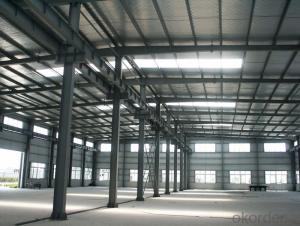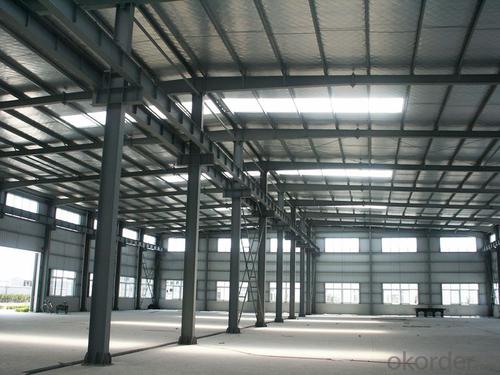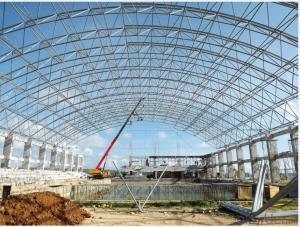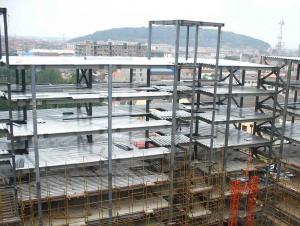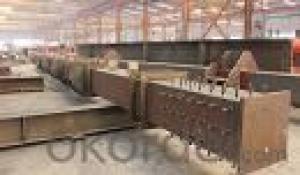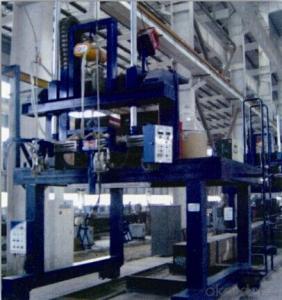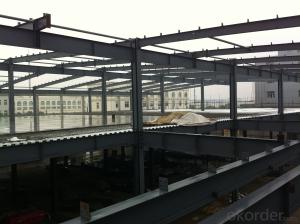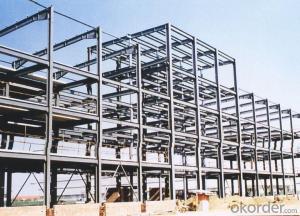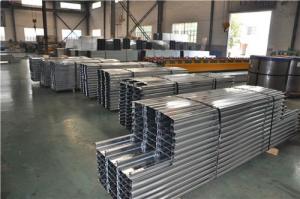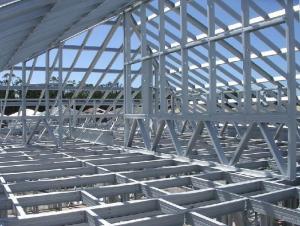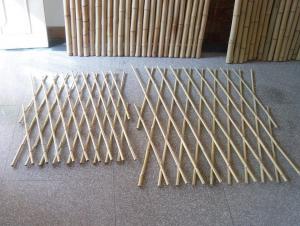High Quality Steel Structure
- Loading Port:
- Nantong
- Payment Terms:
- TT OR LC
- Min Order Qty:
- -
- Supply Capability:
- 200000 m.t./month
OKorder Service Pledge
OKorder Financial Service
You Might Also Like
Steel Structure Warehouse:
1.The steel structure of the connection method: welding connection
2.Steel structure design common norms are as follows: "Steel Design Code" (GB50017-2003) Cold-formed steel structure technical specifications" (GB50018-2002) "Construction Quality Acceptance of Steel" (GB50205-2001) "Technical Specification for welded steel structure" (JGJ81-2002, J218-2002) "Technical Specification for Steel Structures of Tall Buildings" (JGJ99-98)
3.The characteristics of steel Light weight steel structure Higher reliability of steel work Steel anti-vibration (earthquake), impact and good Steel structure for a higher degree of industrialization Steel can be assembled quickly and accurately Large steel interior space Likely to cause sealing structure Steel corrosive Poor fire-resistant steel Recyclable steel shorter duration
4.Commonly used steel grades and performance of steel Carbon
structural steel: Q195, Q215, Q235, Q255, Q275, etc.
High-strength low-alloy structural steel Quality carbon structural steel and alloy structural steel Special purpose steel Product Feature Carport, House, Office, Shop, Toilet, Villa, Warehouse, Workshop, Plant Other Information
Products have been all over the country more than 20 provinces, municipalities and autonomous regions, and have been exported to Europe, North America, the Middle East, Africa, Asia and other countries and regions, the widespread use
Welcome to our factory, we assure that our products will satisfy your needs with designs, competitive performance price ratio and best services.
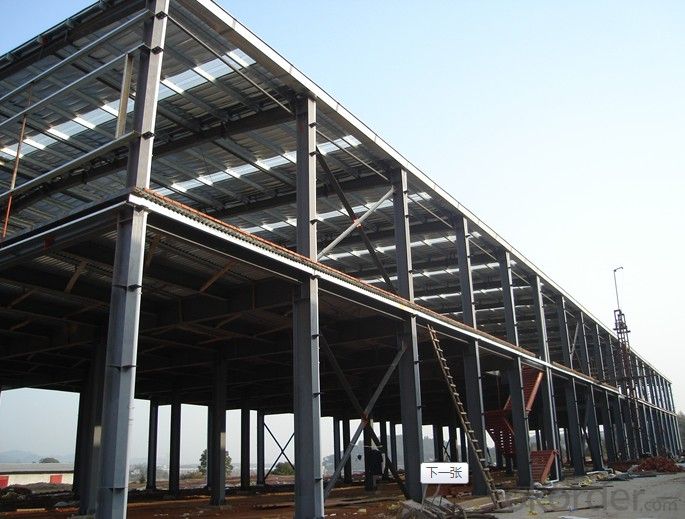
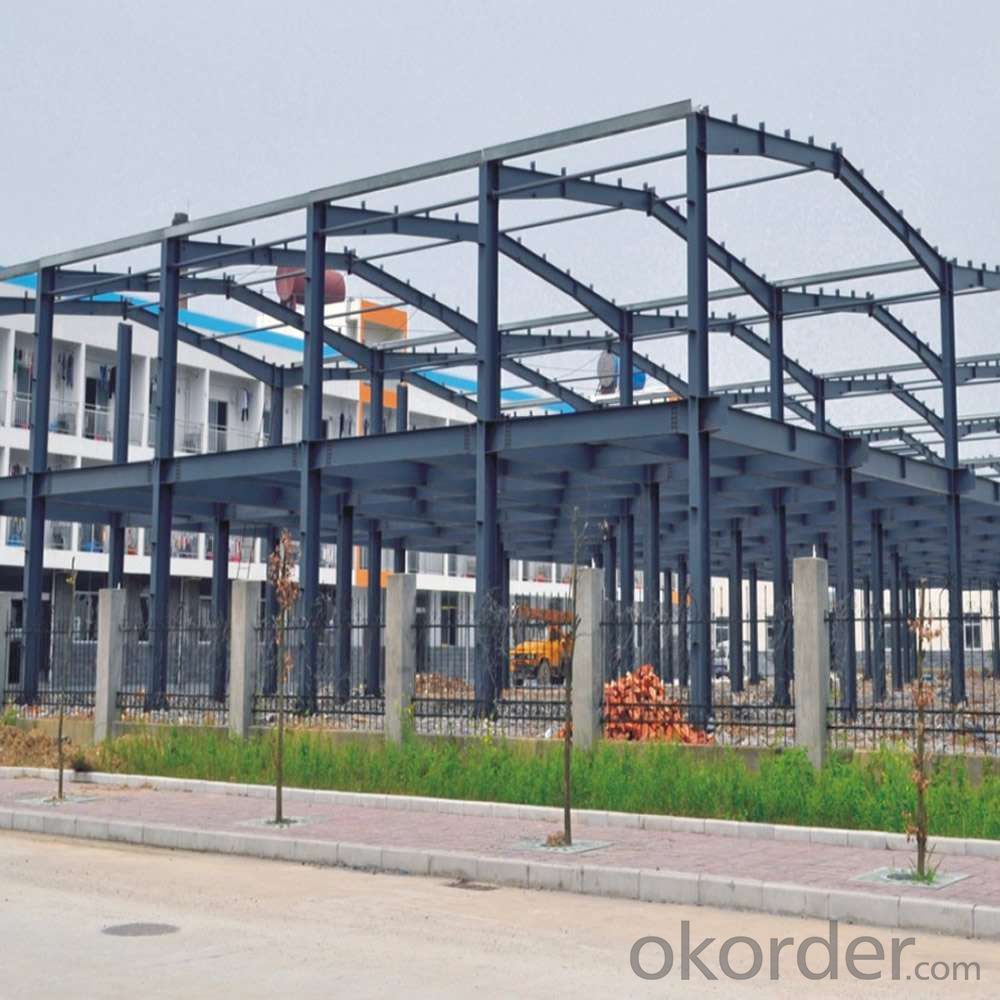
- Q: What are the considerations for designing steel structures for marine environments?
- When designing steel structures for marine environments, several considerations need to be taken into account. Firstly, the steel used should have excellent corrosion resistance to withstand the harsh and corrosive effects of saltwater. This can be achieved by using stainless steel or applying protective coatings to prevent corrosion. Secondly, the design should account for the dynamic loads such as waves, currents, and wind forces that marine structures are subjected to. The structure should be able to withstand these forces without excessive deformation or failure. Thirdly, the design should incorporate proper drainage systems to prevent the accumulation of water, which can increase the risk of corrosion. Adequate ventilation is also essential to minimize moisture buildup and promote air circulation. Furthermore, the structural design should consider the potential impact of marine organisms like barnacles and mussels, which can attach to the structure and cause additional drag and corrosion. Measures such as anti-fouling coatings or regular cleaning may be necessary to mitigate this issue. Lastly, maintenance and inspection plans should be developed to monitor the condition of the steel structure over time. Regular inspections, repairs, and maintenance activities can help identify and address any corrosion or structural issues before they escalate. Overall, designing steel structures for marine environments requires careful consideration of corrosion resistance, dynamic loads, drainage, ventilation, anti-fouling measures, and maintenance plans to ensure the longevity and safety of the structure.
- Q: What are the considerations for designing steel canopies and shade structures?
- Designing steel canopies and shade structures requires careful consideration of several factors. Firstly, the structural integrity of the steel canopy is of utmost importance. Steel is a strong and durable material, but the design needs to account for the loads it will be subjected to such as wind, snow, and potential impacts. Calculations must be made to ensure that the steel frame can withstand these forces without buckling or collapsing. Another important consideration is the aesthetics of the canopy. It should blend harmoniously with its surroundings and complement the overall design of the area. Attention should be given to the shape, size, and color of the structure to create an appealing visual impact. The functionality of the canopy is also crucial. It should provide adequate shade and protection from the elements. The design should take into account the angle of the sun throughout the day to ensure that the shade is effective. Additionally, consideration should be given to the ventilation and airflow underneath the canopy to create a comfortable environment for users. The choice of materials is another consideration. Steel canopies can be fabricated using various types of steel with different finishes. The selection should take into account factors such as corrosion resistance, durability, and maintenance requirements. Coatings and finishes can also be applied to enhance the aesthetics and longevity of the structure. Lastly, the budget and timeline should be considered. Designing and constructing steel canopies can be a significant investment, so it is important to align the design with the available resources. It is also crucial to develop a realistic timeline for the project, considering factors such as fabrication, transportation, and installation. In conclusion, designing steel canopies and shade structures requires considerations for structural integrity, aesthetics, functionality, materials, budget, and timeline. By carefully addressing these factors, a well-designed steel canopy can enhance the visual appeal and functionality of an outdoor space.
- Q: How are steel structures designed to accommodate equipment and machinery?
- Steel structures are designed to accommodate equipment and machinery through careful consideration of their weight, size, and operational requirements. Engineers analyze the load-bearing capacity of the structure, ensuring it can safely support the equipment's weight. They also plan for appropriate spacing and layout to allow for efficient installation, maintenance, and operation of the machinery. Additionally, the structure may incorporate features like reinforced beams, columns, and foundations to provide the necessary stability and durability for the equipment.
- Q: What are the considerations for steel structure design in desert environments?
- Several crucial considerations need to be taken into account when designing steel structures in desert environments. These considerations are vital for ensuring the structure's longevity, safety, and efficiency in extreme environmental conditions. 1. Temperature Extremes: Desert environments experience extreme temperature fluctuations, with scorching heat during the day and significant temperature drops at night. These variations can cause thermal expansion and contraction of steel, potentially leading to structural issues. Designers must carefully account for these temperature changes by incorporating appropriate expansion joints, thermal insulation, and selecting steel grades with high resistance to thermal stress. 2. Corrosion Protection: Low humidity levels in desert environments create an arid and corrosive atmosphere. The presence of sand and dust particles can accelerate the corrosion process. To combat this, special attention should be given to corrosion protection measures such as galvanizing, painting, or the use of weather-resistant steel grades. Regular maintenance and inspections are crucial to identify and address any signs of corrosion early on. 3. Wind and Sandstorms: Strong winds and occasional sandstorms are common in desert regions, exerting significant forces on steel structures. The design should incorporate wind load calculations and consider local wind patterns to ensure structural stability. Additionally, measures should be taken to prevent sand and dust ingress, such as sealing gaps, using fine mesh screens, or incorporating ventilation systems with filters to protect sensitive equipment and prevent structural damage. 4. Foundation Design: The desert soil composition varies greatly, ranging from loose sand to hard-packed clay. The foundation design should consider specific soil conditions to ensure proper load distribution and stability. Soils with low bearing capacity may require deep foundations or techniques like soil stabilization to ensure structural integrity. 5. Solar Radiation: Desert environments receive intense solar radiation, leading to excessive heat gain in structures. To minimize this, designers should incorporate shading devices, reflective coatings, or insulation to reduce energy consumption required for cooling and maintain a comfortable indoor environment. 6. Water Availability: Water scarcity is a common challenge in desert environments. Therefore, the design should prioritize water conservation measures, such as rainwater harvesting systems, efficient plumbing fixtures, and landscaping techniques that minimize water usage. 7. Sustainability: Desert regions often have fragile ecosystems, necessitating prioritization of sustainable design practices to minimize environmental impact. This can include using recycled or locally sourced materials, optimizing energy efficiency through passive design strategies, and incorporating renewable energy sources such as solar panels. In conclusion, the design of steel structures in desert environments necessitates careful consideration of temperature fluctuations, corrosion protection, wind and sandstorms, foundation design, solar radiation, water availability, and sustainability. By addressing these considerations, engineers can ensure the durability, safety, and efficiency of structures in these challenging environments.
- Q: How do steel structures contribute to the overall energy performance of a building?
- There are several ways in which steel structures can greatly impact the energy performance of a building. Firstly, steel is highly efficient in conducting and distributing heat, which helps to maintain a comfortable indoor temperature. Its thermal conductivity allows for a quick and efficient transfer of heat, reducing the need for excessive heating or cooling systems. Furthermore, steel structures can be designed to offer excellent insulation properties. By incorporating insulation materials within the steel framework, buildings can minimize heat loss during cold weather and reduce heat gain during hot weather. This insulation creates a more energy-efficient envelope, decreasing the reliance on heating and cooling systems and ultimately lowering energy consumption. In addition, steel structures enable the construction of larger open spaces and larger windows, allowing more natural light to enter the building. Natural light not only reduces the need for artificial lighting but also provides various health benefits for occupants. By maximizing the use of natural light, steel structures can reduce the energy demand for lighting, further contributing to the overall energy performance of the building. Moreover, steel is a durable and long-lasting material, requiring minimal maintenance throughout its lifespan. This durability reduces the need for frequent repairs or replacements, resulting in lower energy consumption associated with maintenance activities. Finally, steel is a recyclable material, meaning that at the end of a building's life cycle, the steel used in its construction can be recycled and repurposed. This reduces the demand for new steel production, which is a highly energy-intensive process. By incorporating easily recyclable steel structures, buildings can contribute to a more sustainable and energy-efficient construction industry. To sum up, steel structures make a significant contribution to the overall energy performance of a building by facilitating efficient heat transfer, offering excellent insulation, maximizing natural light, minimizing maintenance requirements, and promoting recycling. These factors combine to create a more energy-efficient building, reducing energy consumption and promoting sustainability.
- Q: How are steel sports facilities constructed?
- Steel sports facilities are constructed by first preparing the site and laying the foundation. Then, a steel frame is erected, which serves as the main structural support. The steel beams and columns are bolted together to create the framework of the facility. Next, the walls and roof are installed using steel panels or other cladding materials. The interiors are then finished with concrete floors, seating, and other necessary amenities. Finally, the facility is inspected for safety and functionality before it is ready for use.
- Q: What are the design considerations for steel bridges?
- Some design considerations for steel bridges include the structural integrity and strength of the steel materials used, the weight-bearing capacity of the bridge, the anticipated loads and traffic conditions, the span length and overall length of the bridge, the environmental conditions and potential for corrosion, the aesthetics and architectural design, the cost-effectiveness and ease of construction, and the maintenance requirements of the bridge.
- Q: What are the considerations for steel structure maintenance and repair?
- There are several important considerations for steel structure maintenance and repair. Firstly, regular inspections are crucial to identify any signs of damage or deterioration. This can be done by trained professionals who are familiar with the specific requirements of steel structures. Inspections should cover all components of the structure, including connections, welds, and support systems. Any issues should be addressed promptly to prevent further damage or potential safety hazards. Secondly, proper cleaning and maintenance routines play a key role in the longevity of steel structures. Regular cleaning removes dirt, debris, and corrosion-inducing substances, such as salt or chemicals, which can compromise the integrity of the steel. Cleaning should be done using appropriate methods and products to avoid scratching or damaging the surface of the steel. Another consideration is the need for protective coatings. Steel structures are often coated with paint or specialized coatings to provide protection against corrosion. These coatings should be periodically inspected and maintained to ensure they remain intact and effective. Any areas with peeling, chipping, or other signs of coating failure should be promptly addressed to prevent corrosion from occurring. Furthermore, it is important to assess and address any structural issues that may arise. Over time, steel structures can experience fatigue, stress, or other forms of damage. These issues may require repair or reinforcement, which should be done by qualified professionals following industry standards and codes. In addition to inspections and repairs, it is crucial to monitor and control the environmental conditions surrounding the steel structure. Exposure to excessive moisture, temperature fluctuations, or corrosive chemicals can accelerate the deterioration of steel. Implementing measures such as proper drainage, ventilation, and corrosion inhibitors can help mitigate these risks. Lastly, documentation and record-keeping are essential for effective maintenance and repair of steel structures. Keeping a comprehensive record of inspection reports, maintenance activities, repairs, and any modifications made to the structure can help in tracking the history of the structure, identifying recurring issues, and planning future maintenance activities. Overall, steel structure maintenance and repair involve regular inspections, proper cleaning, protective coatings, addressing structural issues, controlling environmental conditions, and maintaining detailed records. By considering these factors, the lifespan and performance of steel structures can be significantly extended.
- Q: What are the different types of steel trusses used in structures?
- There are several types of steel trusses commonly used in structures, including the Pratt truss, Warren truss, Howe truss, and the K truss. Each truss design has its own unique arrangement of diagonal and vertical members, which determines its load-bearing capacity and suitability for different types of structures.
- Q: What are the safety regulations for steel structure construction?
- Safety regulations for steel structure construction vary depending on the country and jurisdiction. However, some common safety regulations include the use of personal protective equipment (PPE) such as hard hats, safety glasses, and steel-toed boots, proper training and certification for workers, regular inspections and maintenance of equipment, adherence to specific construction codes and standards, implementation of fall protection measures, and the presence of emergency response plans. Additionally, safety regulations often require the use of engineering controls and safety devices to prevent accidents and ensure the structural integrity of steel buildings.
Send your message to us
High Quality Steel Structure
- Loading Port:
- Nantong
- Payment Terms:
- TT OR LC
- Min Order Qty:
- -
- Supply Capability:
- 200000 m.t./month
OKorder Service Pledge
OKorder Financial Service
Similar products
Hot products
Hot Searches
Related keywords
